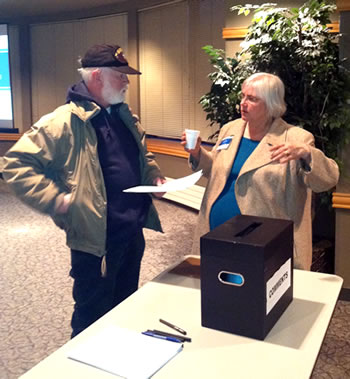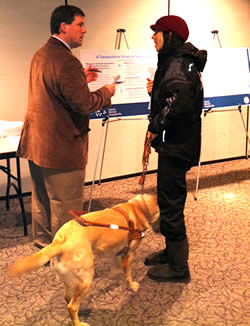 |
|

|
 |
TABLE of CONTENTS
 |
Completion of several innovative, safety-driven projects marks end of 2012 construction season |

Crews floated the main span of the new Hwy 61 Hastings bridge down the Mississippi River from its construction site to the bridge site in late September. Photo by David Gonzalez |
The Maryland Avenue bridge replacement over Interstate 35E in St. Paul, the Hwy 61 bridge project over the Mississippi River in Hastings, and the reconstruction of Hwy 14 between Waseca and Owatonna are among more than 300 state highway and bridge projects that were under construction in 2012.
“The 2012 construction season was certainly one of innovation as MnDOT implemented new technology on several projects aimed at cutting project time and delays for motorists, while increasing safety on our highways and improving the quality of life for all Minnesotans,” said Commissioner Tom Sorel.
Crews worked hard this year to resurface roads, replace bridges, improve drainage systems, repair guard rail, install cable barriers and complete other vital transportation projects.
Projects in the Twin Cities include:
- Maryland Avenue Bridge replacement over I-35E in St. Paul – Work is nearing completion on this one-of-a-kind project that involved the replacement of the Maryland Avenue overpass using an innovative construction method to reduce the length of the road closure. Crews constructed the Maryland Avenue bridge superstructure alongside I-35E near the Maryland Avenue Bridge site and moved it into place after the abutments and piers were completed. Crews used self-propelled modular transporters to move the bridge into place—SPMTs are computer-operated, multi-axle machines that can lift, transport and set heavy loads. (Construction cost: $14 million)
- Hwy 61 Hastings Bridge project over the Mississippi River – The project began in October 2010 and is scheduled for completion in late 2013. Similar to the Maryland Avenue bridge project, this project involved building the main bridge span off site and moving it into place. Crews used SPMTs to move the main span onto several barges so it could be floated down river to the bridge site and lifted into place. (Construction cost: $120 million)
- I-94 resurfacing between St. Paul and Minneapolis – Work is complete on this two-year improvement project that included resurfacing and the installing Smart Lane technology to improve safety and congestion through the I-94 corridor. Additional improvements included drainage repairs, bridge maintenance work, shoulder reconstruction and lane realignment. (Construction cost: $23.9 million)
- I-694 concrete replacement in northeast Twin Cities – Work is wrapping up on this project that started in June. Work includes replacement of the road surface with concrete on about six miles of I-694; the new surface should last 25 to 30 years. The project also includes reinstalling cable median barrier, a key safety feature that can reduce fatal crashes by 90 percent. (Construction cost: $20 million)
- I-494 improvement project in southern Twin Cities – Work is progressing on the resurfacing project that passes through Edina, Bloomington and Richfield. Additional work includes reconstructing the Xerxes Avenue Bridge spanning I-494. Crews are using a movable barrier machine, an innovative device that transfers concrete barriers laterally up to 18 feet in one pass. By using the machine, MnDOT is able to set up and remove lane closures quickly without disrupting rush-hour traffic and while maintaining the safety of motorists and workers. (Construction cost: $30 million)
Projects in northern and central Minnesota include:
-

The newly resurfaced section of I-35 winds its way through Pine County. Photo courtesy of District 1 |
Hwy 23 bypass project in Paynesville—Construction of the nearly eight-mile divided highway bypass around Paynesville concluded in July, more than one month ahead of schedule. Work began in spring 2009. (Construction cost: $32.2 million)
- I-35 reconstruction in Pine County – Work is nearing completion on this project in the Sandstone area. Improvements include concrete resurfacing, bridge repair and ramp reconstruction. (Construction cost: $20.66 million)
- Hwy 23 expansion project between St. Cloud and Foley – Construction is nearing completion on the two-year project that expands Hwy 23 to four lanes from Hwy 95 east of St. Cloud to Highway 25 in Foley. Additional work includes installing pedestrian access improvements. (Construction cost: $26 million)
- Hwy 1 reconstruction between Northome and Effie – Work is complete on the majority of the construction project that included resurfacing Hwy 1, replacing culverts, resurfacing a portion of Hwy 6 north of the junction with Hwy 1 and completing streetscape work in the city of Effie. Crews will finish up landscaping work in spring 2013. (Construction cost: $7.3 million)
- Hwy 59 reconstruction north of Pelican Rapids – Work is complete on a project that included replacing two bridges and resurfacing the road. (Construction cost: $5.2 million)
Projects in southern Minnesota include:
- Hwy 14 between Waseca and Owatonna – Work concluded this year on the multi-year project, which included a new interchange at I-35 and Hwy 14. (Construction cost: $107.8 million)
- Hwy 56 pavement reclamation and resurfacing between West Concord and Kenyon – Work is complete on the project, which included the reclamation and resurfacing of Hwy 56. Pavement reclamation is the process of milling off part of the existing road surface, grinding the remaining pavement and a small layer of the underlying aggregate, injecting oil into the mixture to rebind the material and compact it back into place. The project also included replacing the Hwy 56 bridge over the middle fork of the Root River near West Concord. (Construction cost: $6.3 million)
- Hwy 60 four-lane expansion project between Worthington and Bigelow – The three-phase project began in summer 2010 and is scheduled for completion in 2013. (Construction cost: $70 million)
- Hwy 14 expansion in North Mankato – Work is progressing on a project to expand Hwy 14 to four lanes between Lookout Drive and County Road 6 in North Mankato. Additional work includes building a new interchange at Hwy 14 and County Road 41. (Construction cost: $18 million)
- Hwy 212 resurfacing projects near Montevideo – Work is complete on two separate resurfacing projects between Montevideo and Hwy 75. (Construction costs: $5.8 million, $6.2 million)
For a list of recently completed projects, visit www.dot.state.mn.us/roadwork/complete.html; ongoing projects, visit www.dot.state.mn.us/roadwork/current.html; and future projects, visit www.dot.state.mn.us/roadwork/future.html. |
 |
|

|
 |
TABLE of CONTENTS
 |
Electronic Communications employee dies unexpectedly |

Travis Holmquist, Office of Electronic Communications, shows off his catch on a recent fishing trip. Photo courtesy of District 8. |
Travis Holmquist, Office of Electronic Communications, died unexpectedly Oct. 15 at his home. He was 42 years old.
Holmquist was employed as a mobile radio specialist for the past 21 years. He joined MnDOT in 2008 as a radio technician working out of District 8-Marshall in the radio shop.
“Travis was incredibly well-liked by his co-workers,” said Bruce DeBlieck, Holmquist’s supervisor. “He was a diligent worker, always kept a positive outlook, and enjoyed taking on new challenges. We are all sorry for the unexpected loss of a friend and co-worker. He will be missed.”
Holmquist enjoyed computers, fishing, biking and gardening. He also had a passion for music; Holmquist played tuba, bass guitar and acoustic guitar in several bands.
Holmquist grew up in Cambridge, Minn., and graduated from Cambridge High School in 1989. He continued his education at Willmar Vo-Tech, graduating with his associate degree in 1991. Holmquist is survived by his father, mother, siblings and many other relatives and friends. |
 |
|

|
 |
TABLE of CONTENTS
 |
Updated statewide multimodal plan sets transportation policy framework for next 20 years |

At right, Lynn Bly, Office of Statewide Multimodal Planning, receives input into the plan, a policy framework for maintaining and building Minnesota’s transportation system during the next 20 years. MnDOT file photo |
The Minnesota Statewide Multimodal Transportation Plan 2012-2031, a policy framework for maintaining and building Minnesota’s transportation system during the next 20 years, has been finalized and is available online.
“This plan is the result of extensive collaboration we’ve had during the past year with citizens, stakeholders and partners throughout Minnesota,” said Commissioner Tom Sorel. “I want to thank everyone who took the time to participate in our outreach meetings and provide input. The success of Minnesota’s transportation system depends on these coordinated efforts, and we appreciate the involvement of all who participated in the process.”
The Statewide Multimodal Transportation Plan addresses the entire transportation system, including highways, local streets and roads, transit, railroads, aviation, ports, waterways, and bicycle and pedestrian facilities. It will be used to influence MnDOT’s future investment decisions and shape other transportation plans, such as the State Highway Investment Plan, which currently is in development and will be completed in 2013, and the State Aviation System Plan, a draft of which will be ready for public comment later this fall.
“The Statewide Multimodal Transportation Plan focuses on solutions that ensure a high return-on-investment, and that complement and strengthen the rapidly changing social, environmental and economic climate, with the intent of improving Minnesotans’ quality of life,” Sorel said.
MnDOT’s planning and investment approach involves:
- Applying multimodal solutions that ensure a high return-on-investment, such as the development of a managed lane system (e.g., MnPASS) in the Twin Cities.
- Strategically fixing the system by working with partners to define priority networks, since it will not be feasible to maintain all assets in current condition.
-

Kirby Becker, OSPM, speaks with a visitor at one of several public events held around the state during the past year to gather input for the Statewide Multimodal Planning Plan. MnDOT file photo
|
Building to a maintainable scale to keep Minnesota’s transportation system on a sustainable track for the future.
- Better aligning ownership of Minnesota’s roadways with statewide and local priorities.
Last updated in 2009, the plan is based on an analysis of transportation trends and issues in Minnesota, as well as performance measures covering all transportation modes, system assets and operations that gauge how well the transportation system is functioning.
“I want to thank all the MnDOT offices and staff, including the entire Office of Statewide Multimodal Planning, who contributed throughout the development of this plan,” said Kirby Becker, Statewide Multimodal Transportation Plan project manager. “Their expertise helped make this plan a better product, one that will help shape all our other transportation plans.”
For more information, see:
|
 |
|

|
|

|
 |
TABLE of CONTENTS
 |
Webcast focuses on how MnDOT supports public health |
|
The role transportation plays in public health was the topic of the latest Commissioner Webcast, which aired Oct. 29.
Calling it “transformational thinking,” Commissioner Tom Sorel said that MnDOT was actively engaged with the public health community to ensure that the way the agency makes its transportation investments was integrated into the public health forum.
Minnesota GO, sustainability, the statewide transportation plan, quality of life research, Toward Zero Deaths and Safe Routes to School initiatives are all examples of the ways that MnDOT’s work supports public health.
Deputy Commissioner Bernie Arseneau moderated the 20-minute discussion, which also included Nick Thompson, Policy, Research and Strategic Initiatives Division director; Amy Roggenbuck, Toward Zero Deaths southwest region coordinator; and Lisa Bender, Safe Routes to School coordinator.
The webcast can be found on the iHUB main page under “Commissioner’s Corner,” and at MnDOT supports Public Health webcast (10/31/2012). |
 |
|

|
|

|
 |
TABLE of CONTENTS
 |
Annual symposium emphasizes how to respond to workplace violence |
By Jessica Wiens

MnDOT employees place violence scenarios on the continuum while Dr. James Garbarino (right) looks on. Small groups discussed where on the continuum to place scenarios and what the best response is to each scenario. The exercise was part of the 2012 Workplace Violence Symposium in St. Cloud. Photo by Jessica Wiens |
The recent workplace shooting at Accent Signage Systems in Minneapolis killed five employees and put workplace violence back in the headlines. Workplace violence also was a focus for nearly 90 MnDOT employees who attended the 2012 Workplace Violence Symposium in St. Cloud Oct. 18.
In 2011, MnDOT employees reported 36 violence-related incidents. Members of the MnDOT Violent Incident Advisory Team estimate that only one quarter of workplace violence incidents at MnDOT are actually reported.
VIAT’s message to all MnDOT employees is to report all incidents to a supervisor, manager or VIAT team member immediately, no matter how small the incident may seem.
“Reporting helps MnDOT identify patterns, diffuse situations and prevent workplace violence, said DeLorah Curry," Office of Human Resources and expert in behavior sciences and workplace violence. “It is no different than general violence. It just happens to be at work.”
Government makes up 18 percent of the U.S. workforce, according to the National Criminal Justice Reference Service; yet, 30 percent of victims of workplace violence are federal, state or local government employees.
The symposium hosted Dr. James Garbarino, author and professor at Loyola University in Chicago. Garbarino specializes in studying what causes violence in children, how they cope with it and how to rehabilitate them. He has authored, co-authored or edited more than 20 books about the psychology behind violence.
Most violence is not particularly surprising, according to Garbarino. After a violent incident, looking back the signs are quite clear and the stories of the violent employees have extremely similar trends. The difficulty comes with identifying and acting on the signs before an incident occurs.
Garbarino says the pool of people who have the potential to be violent is huge compared to the people who actually become violent. He generalized violent people as untreated, traumatized children inhabiting scary adult male bodies.
In general, men are much more likely to commit workplace violence than women, but that gap is narrowing. Cultural forces have historically suppressed women from being violent.
In workplace violence situations, the intervention becomes diagnostic. A person’s response to the intervention is key to discovering if the employee has the potential for bigger issues. Employees who are defensive and do not believe what they did was wrong should raise a major red flag. This is why reporting small incidents is key to preventing more destructive workplace violence.
Symposium attendees also discussed the workplace violence continuum, where possible incidents fall on that continuum, and the best way to respond to those incidents.
Curry works with managers and supervisors and uses a high-risk worksheet as one of many tools to assess an accumulation of workplace violence risk factors for employees.
“When we identify a number of risk factors, we can address them and the employee as comprehensively and quickly as possible,” Curry said. “This is one of many things we do to mitigate, diffuse and assess workplace violence.”
Employees can learn more and view videos about workplace violence, how to prevent it and how to protect themselves in a violent incident by visiting the VIAT iHUB website. All employees are required to take workplace violence web-based training within 90 days of hire and again every three years. |
 |
|

|
 |
TABLE of CONTENTS
 |
Better Roads program wins international award |
MnDOT recently won an award for its Better Roads for a Better Minnesota infrastructure improvement program from the International Road Federation. The department will receive the award in January 2013 at the Annual IRF Awards Luncheon in Washington, D.C.
“It is a significant honor to win this award,” said Commissioner Tom Sorel. “Transportation agencies and businesses from across the world compete. It says a great deal about Minnesota’s innovative transportation engineering and delivery efforts.”
Initiated in 2011, the Better Roads for a Better Minnesota is a four-year program that will:
- Improve more than 700 miles of roads
- Upgrade transit in the Twin Cities metro area, including MnPASS expansion and shoulder hardening for transit
- Increase safety and ADA accessibility while improving infrastructure, such as drainage facilities
- Explore innovative engineering and delivery techniques to get the most for the taxpayer dollar
- Provide jobs for Minnesota citizens
“This program is one of MnDOT’s key efforts to address state road pavement conditions, which our research and performance measures tell us are declining faster than our investments can keep up,” Sorel said. “The Better Roads program allows us to get the highest return on our transportation investments by exploring use of innovative methods of contracting, design and construction.”
The award is part of the IRF’s annual Global Roads Achievement Awards program. Better Roads won in the Project Finance and Economics category. Entries in this category are judged on planning, innovative funding, constructing and/or operating a project in a cost efficient manner.
For more information about the Better Roads for a Better Minnesota program, visit www.dot.state.mn.us/betterroads/.
IRF is a non-governmental, not-for-profit organization with the mission to encourage and promote development and maintenance of better, safer and more sustainable roads and road networks. |
 |
|
| |
|



